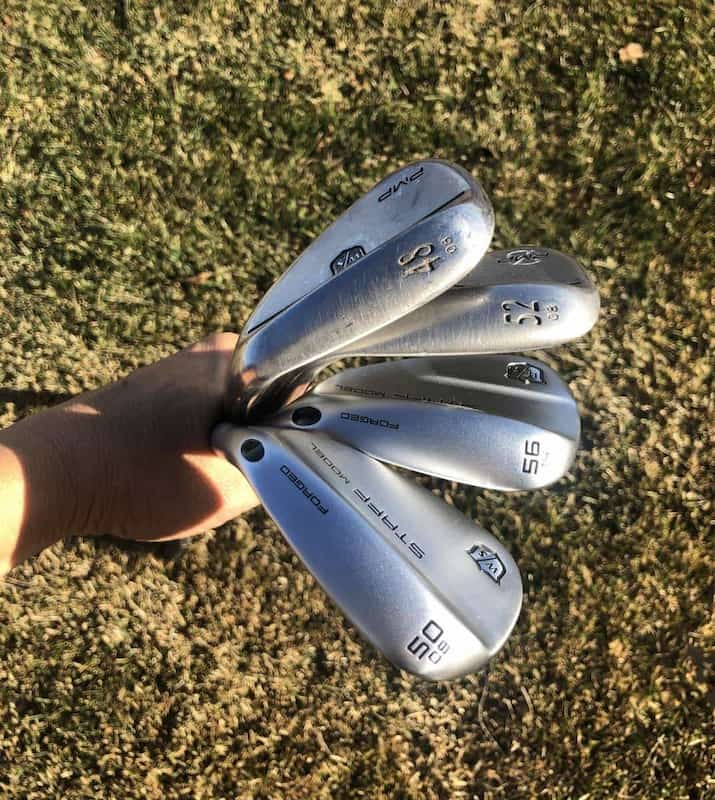Understanding golf wedges can be beneficial when choosing what wedges are right for your game. Every aspect of a golf wedge should be considered and should look comfortable in your eyes when setting up over a ball. The loft, bounce, grind, width, grooves, face and the shape of the wedges are all created to make you feel confident over the ball so if you understand the purpose behind each of these parts, you can properly choose the right wedges for your golf game.
I explain to my students that when it comes to the short game and using your golf wedges, it is an artform. This means that you can be in so many different scenarios when you get closer or around the green that you have to visualize your next shot on how the golf ball comes out the grass, what trajectory it takes, how it will bounce and how much the ball will roll.
You will then have to pick one of your wedges to hopefully make that a reality and make the golf ball react to how you visualized it. Read my posts on Golf Pitching 101 and Golf Chipping 101 to learn how to approach your wedge shots.
So take some time on the chipping green and imagine different situations and practice different types of shots using all of your wedges to learn how to use them and when to use them. I will go over the basics of the wedges and how to choose the right wedges among the 14 clubs in your golf bag.
Choose the Lofts, not the Names
Golfers who start looking into purchasing new clubs or upgrading their club set need to find out what their stock (club manufacturer standard issued loft) pitching wedge loft degree is that is part of their irons set. You can then build your case on what wedges you will need for all of the scenarios you may encounter around the greens.
Build your wedge set strategically, so you have a shot for every yardage and scenario around the greens by choosing the lofts of the wedges.
Why Carry Multiple Wedges?
It seems simple but let’s make sure you understand why there are multiple wedges you are carrying in your bag. These clubs are just an extension of your irons set but more precise. You typically have 3 degrees loft difference in each of the longer irons and then 4 degrees difference in your middle-higher irons. This is when it gets tricky when it comes to your wedges. Your wedges don’t need to be exactly a 4 degree difference among them but you need to understand how they work in your game.
Let’s say your pitching wedge is 48 degrees which was the norm but many club companies are starting to set their irons one to two degrees lower so you can get a few extra yards out of their clubs. Either way, in this case, you want to try and keep it at a 4 degree difference all the way through your wedges so I would carry a 52 degree Gap wedge and a 56 degree sand wedge (the names don’t mean anything as long as the lofts are correct). If I have an extra spot in my golf bag without exceeding 14 clubs, I would add a 60 degree Lob wedge as well.
My Wedge Breakdown
In my case, my pitching wedge is a stock 46 degree loft so I carry a 50 degree Gap wedge and a 56 degree Sand wedge. I have a 6 degree difference there but I love using my gap wedge at any yardage up to a full swing to the full swing of my sand wedge. So here is the breakdown of my wedges and distances I use them for when I want to come in with a full swing or a pitch shot.
- Pitching Wedge (46 deg) – 150 yards (full swing)
- Gap Wedge (50 deg) – 140-115 yards (full swing to ¾ swing)
- Sand Wedge (56 dge) – 110 yards and less (full swing to ¼ swing)
I use all of my wedges for chipping depending on the three factors of my scenario
- Lie of the ball
- Hole location / what is in between my golf ball and the hole?
- Appropriate wedge to use to perform what I visualized for the perfect chip shot
What Does Bounce Mean on a Wedge?
The bounce of a wedge means the angle that is made from the leading edge of the wedge club to the bottom part of the sole. So when you swing and the sole hits the ground, the angle will determine if the leading edge is higher off the ground or closer to it. The bounce also affects how wide the sole is and the curve of it.
The bounce of a wedge is labeled next to the loft degree number on the clubface of your wedge.
Bounce is meant to be forgiving and very helpful to everyone. The name comes from when the sole “bounces” off the ground instead of digging into the ground even if the contact is not perfect. Bounces can also be altered at setup if you are to open the face.
To break this down easier, let’s break the bounce in three levels and explain them and what would be better for you.
High Bounce (10 degrees or higher)
- Ideal conditions: Good for soft turf and soft sand
- Swing type: Helps steep or deep divots swings
- Notes: Generates the most spin
Mid Bounce (6-10 degrees)
- Ideal conditions: Good for normal to firm turf
- Swing Type: Helps wide variety of swings
- Notes: Used for average to good players
Low Bounce (4-6 degrees)
- Ideal conditions: Good for normal to firm turf
- Swing Type: Clean contact swings
- Notes: Used in lob wedges for higher trajectory shots


